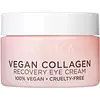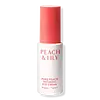What's inside
What's inside
 Key Ingredients
Key Ingredients

 Benefits
Benefits

 Concerns
Concerns

 Ingredients Side-by-side
Ingredients Side-by-side

Water
Skin ConditioningCetearyl Olivate
Caprylic/Capric Triglyceride
MaskingCetearyl Alcohol
EmollientGlycerin
HumectantSorbitan Olivate
EmulsifyingGlyceryl Caprylate
EmollientGlyceryl Stearate Se
EmulsifyingSr-Hydrozoan Polypeptide-1
HumectantChamomilla Recutita Flower Extract
MaskingCalendula Officinalis Flower Extract
MaskingCitrus Aurantium Dulcis Flower Extract
Skin ConditioningRosmarinus Officinalis Leaf Extract
AntimicrobialHydrolyzed Brassica Napus Seedcake Extract
Skin ConditioningJasminum Officinale Flower Extract
MaskingArnica Montana Flower Extract
MaskingLeuconostoc/Radish Root Ferment Filtrate
AntimicrobialCamellia Oleifera Seed Oil
Skin ConditioningHydrolyzed Jojoba Esters
Skin ConditioningCaffeine
Skin ConditioningAllantoin
Skin ConditioningPanthenol
Skin ConditioningSodium Hyaluronate
HumectantTocopherol
AntioxidantQuartz
AbrasiveOpuntia Ficus-Indica Seed Oil
EmollientArginine
MaskingBentonite
AbsorbentCoconut Alkanes
EmollientCoco-Caprylate/Caprate
EmollientCetyl Esters
EmollientStearic Acid
CleansingCetearyl Glucoside
EmulsifyingXanthan Gum
EmulsifyingMaltodextrin
AbsorbentGlucose
HumectantPhenoxyethanol
PreservativePotassium Sorbate
PreservativeSodium Benzoate
MaskingWater, Cetearyl Olivate, Caprylic/Capric Triglyceride, Cetearyl Alcohol, Glycerin, Sorbitan Olivate, Glyceryl Caprylate, Glyceryl Stearate Se, Sr-Hydrozoan Polypeptide-1, Chamomilla Recutita Flower Extract, Calendula Officinalis Flower Extract, Citrus Aurantium Dulcis Flower Extract, Rosmarinus Officinalis Leaf Extract, Hydrolyzed Brassica Napus Seedcake Extract, Jasminum Officinale Flower Extract, Arnica Montana Flower Extract, Leuconostoc/Radish Root Ferment Filtrate, Camellia Oleifera Seed Oil, Hydrolyzed Jojoba Esters, Caffeine, Allantoin, Panthenol, Sodium Hyaluronate, Tocopherol, Quartz, Opuntia Ficus-Indica Seed Oil, Arginine, Bentonite, Coconut Alkanes, Coco-Caprylate/Caprate, Cetyl Esters, Stearic Acid, Cetearyl Glucoside, Xanthan Gum, Maltodextrin, Glucose, Phenoxyethanol, Potassium Sorbate, Sodium Benzoate
Water
Skin ConditioningCetyl Ethylhexanoate
EmollientPropanediol
SolventButylene Glycol
Humectant1,2-Hexanediol
Skin ConditioningGlycerin
HumectantNiacinamide
SmoothingCetearyl Alcohol
EmollientSodium Hyaluronate
HumectantSodium Acetylated Hyaluronate
HumectantHydrolyzed Hyaluronic Acid
HumectantBambusa Textilis Stem Extract
Skin ConditioningArctium Lappa Root Extract
Skin ConditioningMorus Alba Leaf Extract
Skin ConditioningPrunus Persica Fruit Extract
AbrasiveBakuchiol
AntimicrobialRosa Rubiginosa Seed Oil
EmollientDaucus Carota Sativa Root Water
MaskingBrassica Oleracea Italica Extract
AstringentPanax Ginseng Root Extract
EmollientSpinacia Oleracea Leaf Extract
Skin ConditioningAloe Barbadensis Leaf Extract
EmollientAcetyl Octapeptide-3
HumectantCamellia Sinensis Leaf Extract
AntimicrobialCucumis Sativus Extract
Skin ConditioningApium Graveolens Extract
Skin ConditioningMelia Azadirachta Leaf Extract
Skin ConditioningCaprylyl Glycol
EmollientSorbitan Olivate
EmulsifyingLactuca Scariola Sativa Leaf Extract
Skin ConditioningCeramide NP
Skin ConditioningCoccinia Indica Fruit Extract
Skin ConditioningMelia Azadirachta Flower Extract
Skin ConditioningTocopheryl Acetate
AntioxidantFerulic Acid
AntimicrobialTocopherol
AntioxidantPanthenol
Skin ConditioningCaprylic/Capric Triglyceride
MaskingMangifera Indica Seed Butter
Skin ConditioningAdenosine
Skin ConditioningCetearyl Olivate
Hydrogenated Rapeseed Alcohol
EmollientBetaine
HumectantAcrylates/C10-30 Alkyl Acrylate Crosspolymer
Emulsion StabilisingTromethamine
BufferingEthylhexylglycerin
Skin ConditioningPolyglyceryl-4 Oleate
EmulsifyingGlyceryl Olivate
EmollientGlyceryl Stearate
EmollientPropylene Glycol
HumectantAsparagus Officinalis Extract
Skin ConditioningHydrogenated Lecithin
EmulsifyingPhosphoric Acid
BufferingCorallina Officinalis Extract
Skin ConditioningWater, Cetyl Ethylhexanoate, Propanediol, Butylene Glycol, 1,2-Hexanediol, Glycerin, Niacinamide, Cetearyl Alcohol, Sodium Hyaluronate, Sodium Acetylated Hyaluronate, Hydrolyzed Hyaluronic Acid, Bambusa Textilis Stem Extract, Arctium Lappa Root Extract, Morus Alba Leaf Extract, Prunus Persica Fruit Extract, Bakuchiol, Rosa Rubiginosa Seed Oil, Daucus Carota Sativa Root Water, Brassica Oleracea Italica Extract, Panax Ginseng Root Extract, Spinacia Oleracea Leaf Extract, Aloe Barbadensis Leaf Extract, Acetyl Octapeptide-3, Camellia Sinensis Leaf Extract, Cucumis Sativus Extract, Apium Graveolens Extract, Melia Azadirachta Leaf Extract, Caprylyl Glycol, Sorbitan Olivate, Lactuca Scariola Sativa Leaf Extract, Ceramide NP, Coccinia Indica Fruit Extract, Melia Azadirachta Flower Extract, Tocopheryl Acetate, Ferulic Acid, Tocopherol, Panthenol, Caprylic/Capric Triglyceride, Mangifera Indica Seed Butter, Adenosine, Cetearyl Olivate, Hydrogenated Rapeseed Alcohol, Betaine, Acrylates/C10-30 Alkyl Acrylate Crosspolymer, Tromethamine, Ethylhexylglycerin, Polyglyceryl-4 Oleate, Glyceryl Olivate, Glyceryl Stearate, Propylene Glycol, Asparagus Officinalis Extract, Hydrogenated Lecithin, Phosphoric Acid, Corallina Officinalis Extract
Ingredients Explained
These ingredients are found in both products.
Ingredients higher up in an ingredient list are typically present in a larger amount.
This ingredient is an emollient, solvent, and texture enhancer. It is considered a skin-softener by helping the skin prevent moisture loss.
It helps thicken a product's formula and makes it easier to spread by dissolving clumping compounds.
Caprylic Triglyceride is made by combining glycerin with coconut oil, forming a clear liquid.
While there is an assumption Caprylic Triglyceride can clog pores due to it being derived from coconut oil, there is no research supporting this.
Learn more about Caprylic/Capric TriglycerideCetearyl alcohol is a mixture of two fatty alcohols: cetyl alcohol and stearyl alcohol. It is mainly used as an emulsifier. Emulsifiers help prevent the separation of oils and products. Due to its composition, it can also be used to thicken a product or help create foam.
Cetearyl alcohol is an emollient. Emollients help soothe and hydrate the skin by trapping moisture.
Studies show Cetearyl alcohol is non-toxic and non-irritating. The FDA allows products labeled "alcohol-free" to have fatty alcohols.
This ingredient is usually derived from plant oils such as palm, vegetable, or coconut oils. There is debate on whether this ingredient will cause acne.
Due to the fatty acid base, this ingredient may not be Malassezia folliculitis safe.
Learn more about Cetearyl AlcoholCetearyl Olivate is an emulsifier and texture enhancer. It is derived from the fatty acids of olive oil and Cetearyl alcohol, and is biodegradable.
As an emulsifier, it is used to prevent oils and waters from separating. It can also
Manufacturers use the name Olivem 1000. This ingredient has been found to preserve the natural microbiome of skin. Having a healthy microbiome helps keep our skin healthy and protects against harmful bacteria. This ingredient is grouped with Sorbitan Olivate under the name Olivem 1000.
Learn more about Cetearyl OlivateGlycerin is already naturally found in your skin. It helps moisturize and protect your skin.
A study from 2016 found glycerin to be more effective as a humectant than AHAs and hyaluronic acid.
As a humectant, it helps the skin stay hydrated by pulling moisture to your skin. The low molecular weight of glycerin allows it to pull moisture into the deeper layers of your skin.
Hydrated skin improves your skin barrier; Your skin barrier helps protect against irritants and bacteria.
Glycerin has also been found to have antimicrobial and antiviral properties. Due to these properties, glycerin is often used in wound and burn treatments.
In cosmetics, glycerin is usually derived from plants such as soybean or palm. However, it can also be sourced from animals, such as tallow or animal fat.
This ingredient is organic, colorless, odorless, and non-toxic.
Glycerin is the name for this ingredient in American English. British English uses Glycerol/Glycerine.
Learn more about GlycerinPanthenol is a common ingredient that helps hydrate and soothe the skin. It is found naturally in our skin and hair.
There are two forms of panthenol: D and L.
D-panthenol is also known as dexpanthenol. Most cosmetics use dexpanthenol or a mixture of D and L-panthenol.
Panthenol is famous due to its ability to go deeper into the skin's layers. Using this ingredient has numerous pros (and no cons):
Like hyaluronic acid, panthenol is a humectant. Humectants are able to bind and hold large amounts of water to keep skin hydrated.
This ingredient works well for wound healing. It works by increasing tissue in the wound and helps close open wounds.
Once oxidized, panthenol converts to pantothenic acid. Panthothenic acid is found in all living cells.
This ingredient is also referred to as pro-vitamin B5.
Learn more about PanthenolSodium Hyaluronate is hyaluronic acid's salt form. It is commonly derived from the sodium salt of hyaluronic acid.
Like hyaluronic acid, it is great at holding water and acts as a humectant. This makes it a great skin hydrating ingredient.
Sodium Hyaluronate is naturally occurring in our bodies and is mostly found in eye fluid and joints.
These are some other common types of Hyaluronic Acid:
Learn more about Sodium HyaluronateSorbitan Olivate is created from the fatty acids in olive oil and sorbitol.
This ingredient is an oil in water emulsifier. It helps stabilize a product by preventing oils and waters from separating. Sorbitan Olivate also helps hydrate the skin.
Manufacturers sell sorbitan olivate under the name OliveM 1000. OliveM 1000 a multifunctional ingredient. It is self-emulsifying. According to a manufacturer, OliveM 1000 does not disrupt natural skin biome.
Due to its olive oil base, this ingredient may not be fungal-acne safe.
Learn more about Sorbitan OlivateTocopherol (also known as Vitamin E) is a common antioxidant used to help protect the skin from free-radicals and strengthen the skin barrier. It's also fat soluble - this means our skin is great at absorbing it.
Vitamin E also helps keep your natural skin lipids healthy. Your lipid skin barrier naturally consists of lipids, ceramides, and fatty acids. Vitamin E offers extra protection for your skin’s lipid barrier, keeping your skin healthy and nourished.
Another benefit is a bit of UV protection. Vitamin E helps reduce the damage caused by UVB rays. (It should not replace your sunscreen). Combining it with Vitamin C can decrease sunburned cells and hyperpigmentation after UV exposure.
You might have noticed Vitamin E + C often paired together. This is because it is great at stabilizing Vitamin C. Using the two together helps increase the effectiveness of both ingredients.
There are often claims that Vitamin E can reduce/prevent scarring, but these claims haven't been confirmed by scientific research.
Learn more about TocopherolWater. It's the most common cosmetic ingredient of all. You'll usually see it at the top of ingredient lists, meaning that it makes up the largest part of the product.
So why is it so popular? Water most often acts as a solvent - this means that it helps dissolve other ingredients into the formulation.
You'll also recognize water as that liquid we all need to stay alive. If you see this, drink a glass of water. Stay hydrated!
Learn more about Water